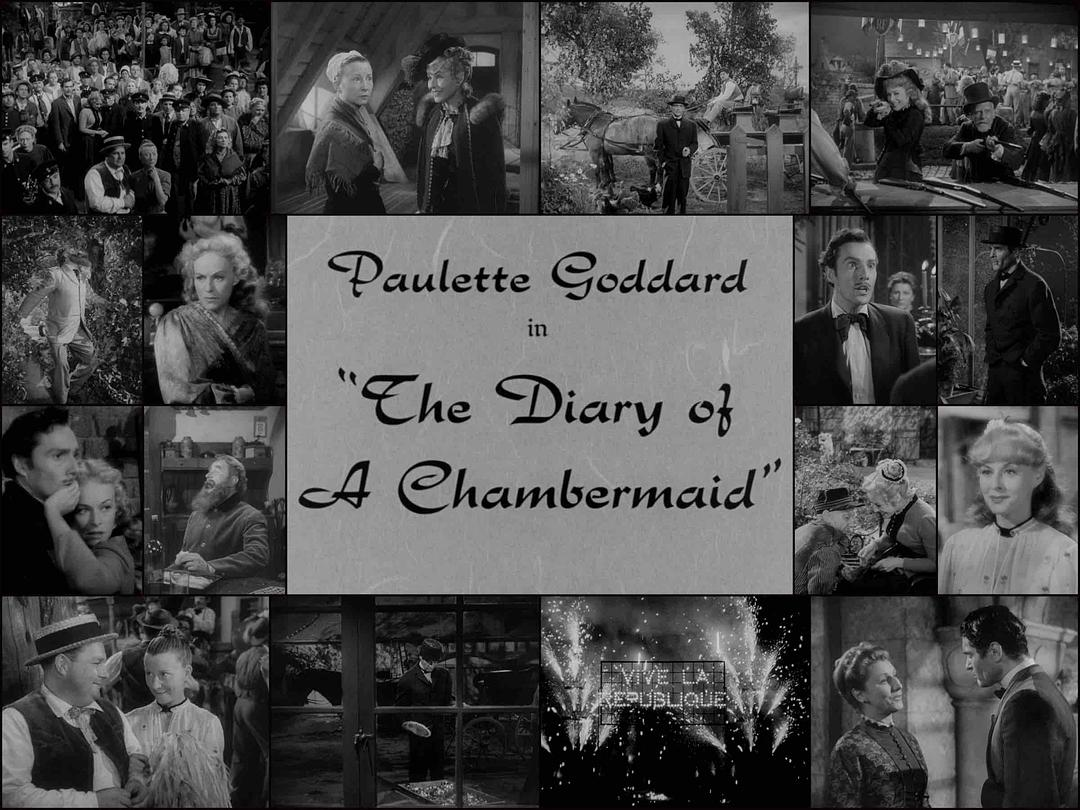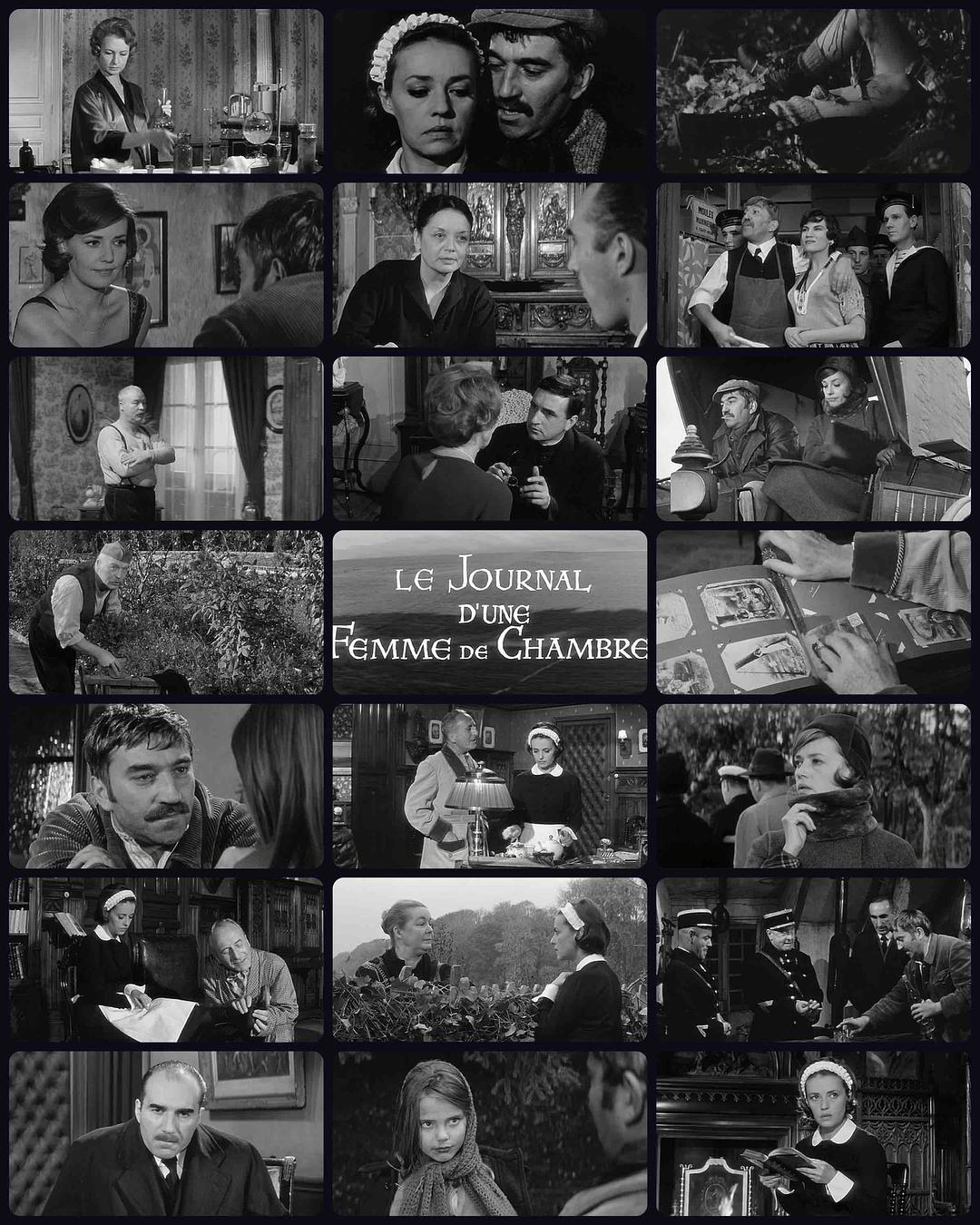1、宝莲·高黛,布吉斯·梅迪斯,Hurd,Hatfield 主演的电影《女仆日记》来自哪个地区?
爱奇艺网友:电影《女仆日记》来自于美国地区。
2、《女仆日记》是什么时候上映/什么时候开播的?
本片于1946年在美国上映,《女仆日记》上映后赢得众多观众的喜爱,网友总评分高达1974分,《女仆日记》具体上映细节以及票房可以去百度百科查一查。
3、电影《女仆日记》值得观看吗?
《女仆日记》总评分1974。月点击量666次,是值得一看的剧情片。
4、《女仆日记》都有哪些演员,什么时候上映的?
答:《女仆日记》是1946-02-15上映的剧情片,由影星宝莲·高黛,布吉斯·梅迪斯,Hurd,Hatfield主演。由导演让·雷诺阿携幕后团队制作。
5、《女仆日记》讲述的是什么故事?
答:剧情片电影《女仆日记》是著名演员宝莲· 代表作,《女仆日记》免费完整版1946年在美国隆重上映,希望你能喜欢女仆日记电影,女仆日记剧情:Celestine, the chambermaid, has a new job in the country, at the Lanlaires. She has decided to use her beauty to seduce a wealthy man. But Mr Lanlaire is not a right choice all the house is firmly controlled by Mme Lanlaire, helped by the strange valet Joseph. Then she tries the neighbour, ex-officer Mauger. This seems to work. But soon the son of the Lanlaires comes back. He is young, attractive, and does not share his mother's anti-republicans opinions. So Celestine's beauty attracts Captain Mauger, young Georges Lanlaire, and also Joseph. Three men, from three different social classes, with
布努埃尔版本,是对伪善资产阶级的讽刺挪揄。而雷诺阿版本只有正邪对立,泾渭分明,非黑即白,没有灰色地带,无聊至极。n本来雷诺阿在欧洲时的前期作品,在对底层人民充满同情的同时,就总是有一种挥之不去的正义感,道德感。等他到了美国,在套路式的故事框架,流水线式的剪辑,义正辞严的美式演员的加持下,这种正义感、道德感愈发加重了。
n"L'esprit antibourgeois du Journal d'une femme de chambre,d'Octave Mirbeau,séduit Jean Renoir qui,en association avec l'acteur BurgessnMeredith, l'adapte à l'écran. Le résultat choque le public des deux côtés de l'Atlantique pour la liberté prise autant avec la forme qu'aveo l'histoire."
"L'esprit antibourgeois du Journal d'une femme de chambre,d'Octave Mirbeau,séduit Jean Renoir qui,en association avec l'acteur BurgessnMeredith, l'adapte à l'écran. Le résultat choque le public des deux côtés de l'Atlantique pour la liberté prise autant avec la forme qu'aveo l'histoire."n"Lc film est trop étrange pour plaire à un grandnpublic, américain ou français. Situé dans un décor artificiel qui n'a rien à voir avec la France du début du siècle ou avec le réalismende Mirbeau, c'est une sorte de drame burlesque, audacieux par le mélange de fantaisie grinçante et d'atmosphère de westernde série B qu'évoque le style des costumes et des constructions de carton-pâte des studios hollywoodiens. L'ensemble est à l'échelle des outrances de l'invraisemblable Mauger de Burgess Meredith. Le film est loin du moralisme recherché,pourtant il est classé parmi les dix meilleurs de l'année. Quinze ans plus tard, Jean Renoir déclarera dans une interview : Le Journal d'une femme de chambre correspond à une de mes crisesnantiréalistes.》."n
Title: The Diary of a Chambermaid
Year: 1946
Country: USA
Language: English
Genre: Drama, Romance
Director: Jean Renoir
Screenplay: Burgess Meredith
based on the play of André Heuzé, André de Lorde and Thielly Norès
adapted from the novel by Octave Mirbeau
Music: Michel Michelet
Cinematography: Lucien N, Andriot
Cast:
Paulette Goddard
Francis Lederer
Hurd Harfield
Burgess Meredith
Judith Anderson
Reginald Owen
Irene Ryan
Florence Bates
Almira Sessions
Sumner Getchell
Rating: 7.5/10
English Title: Diary of a Chambermaid
Original Title: Le journal d’une femme de chambre
Year: 1964
Country: France, Italy
Language: French
Genre: Crime, Drama
Director: Luis Buñuel
Writers:
Luis Buñuel
Jean-Claude Carrière
based on the novel by Octave Mireau
Cinematography: Roger Fellous
Cast:
Jeanne Moreau
George Géret
Michel Piccoli
Françoise Lugagne
Jean Ozenne
Daniel Ivernel
Gilbert Géniat
Muni
Jean-Claude Carrière
Dominique Sauvage
Bernard Musson
Rating: 7.9/10

A double-bill of two films transmuting Octave Mirbeau's source novel LE JOURNAL D’UNE FEMME DE CHAMBREonto the celluloid, made bytwo cinematic titans:Jean Renoir and Luis Buñuel, 18 years apart.
Renoir’s version is made in 1946 during his Hollywood spell, starring Paulette Goddard as our heroine Celestine, a Parisian girl arrives in the rural Lanlaire mansion to work as the chambermaid in 1885, barely alighting from the train, Celestine has already been rebuffed by the haughty valet Joseph (an excellently surly Lederer), and confides to the also newly arrived scullery maid Louise (a mousy and dowdy Irene Ryan) that she will do whatever in her power to advancing her social position and firmly proclaims that love is absolutely off limits, and the film uses the literal diary-writing sequences as a recurrent motif to trace Celestine’s inner thoughts.
The objects of her tease are Captain Lanlaire (Owen), the patriarch who has relinquished his monetary sovereignty to his wife (Judith Anderson, emanating a tangy air of gentility and callousness); and Captain Mauger (a comical Burgess Meredith, who also pens the screenplay off his own bat), the Lanlaire's goofy neighbor who has a florae-wolfing proclivity and is perennially at loggerheads with the former on grounds of the discrepancy in their political slants, both are caricatured as lecherous old geezers with the death of a pet squirrel prefiguring the less jaunty denouement.
In Renoir’s book, the story has a central belle-époque sickly romantic sophistication to sabotage Celestine’s materialistic pursuit, here her love interest is George (Hurd Hatfield), the infirm son of the Lanlaire family, a defeatist borne out of upper-crust comfort and has no self-assurance to hazard a courtship to the one he hankers after. Only when Joseph, a proletariat like Celestine, turns murderous and betrays his rapacious nature, and foists a hapless Celestine into going away with him, is George spurred into action, but he is physically no match of Joseph, only with the succor from the plebeianmob on the Bastille Day, Celestine is whisked out of harm’s way, the entire process is shrouded by a jocose and melodramatic state of exigency and Renoir makes ascertain that its impact is wholesome and wonderfully eye-pleasing.
In paralleled with Buñuel’s interpretation of the story, Renoir has his innate affinity towards the aristocracy (however ludicrous and enfeebled are those peopled) and its paraphernalia, the story is less lurid and occasionally gets off on a comedic bent through Goddard’s vibrant performance juggling between a social-climber and a damsel-in-distress.

The same adjective“comedic”,“vibrant” certainly doesn’t pertain to Buñuel’s version, here the time-line has been relocated to the mid-1930s, Celestine (played by Jeanne Moreau with toothsome reticence and ambivalence) more often than not, keeps her own counsel, we don’t even once see her writing on the titular diary, she works for Mr. and Mrs Monteil (Piccoli and Lugagne), who are childless but live with Madame’s father Mr. Rabour (Ozenne, decorous in his condescending aloofness), an aristo secretly revels in boots fetish in spite of his dotage. Here the bourgeois combo is composed of a frigid and niggardly wife, a sexed-up and henpecked husband (Mr. Piccoli makes for a particularly farcical womanizer, armed with the same pick-up line), a seemingly genteel but kinky father, and Captain Mauger (Ivernel), here is less cartoonish but no less uppity, objectionable and erratic; whereas Joseph (Géret), is a rightist, anti-Semitic groom whose perversion is to a great extent much more obscene (rape, mutilation and pedophilia are not for those fainted hearts).
Amongst those anathemas, Celestine must put on her poker face, or sometimes even a bored face to be pliant (she even acquiesces to be called as Marie which Goddard thinks better of in Renoir’s movie), she is apparently stand-offish but covertly rebellious, and when a heinous crime occurs (a Red Riding Hood tale garnished with snails), she instinctively decides to seek justice and tries insinuating her way into a confession from the suspect through her corporeal submission, only the perpetrator is not a dolt either, unlike Renoir's Joseph, he knows what is at stakes and knows when to jettison his prey and start anew, that is a quite disturbing finale if one is not familiar with an ending where a murderer gets away with his grisly crime. But Buñuel cunningly precedes the ending with a close-up of a contemplating Celestine, after she finally earns her breakfast-in-bed privilege, it could suggest that what followed is derived from her fantasy, which can dodge the bullet if there must be.
Brandishing his implacable anti-bourgeoisie flag, Buñuel thoughtfully blunts his surrealistic abandon to give more room for dramaturgy and logical equilibrium, which commendably conjures up an astringentsatire laying into the depravity and inhumanity of the privileged but also doesn’t mince words in asserting that it doesn’t live and die with them, original sin is immanent, one just cannot be too watchful.
Last but definitely not the least, R.I.P. the one and only Ms. Moreau, who just passed away at the age of 89, and in this film she is a formidable heroine, brave, sultry and immune to all the mushy sentiments, whose fierce, inscrutable look is more than a reflection of her temperaments, but a riveting affidavit of a bygone era’s defining feature.
referential points: Renoir’s THE RIVER (1951, 7.1/10), FRENCH CANCAN (1955, 7.0/10), ELENA AND HER MEN (1956, 5.2/10) and THE RULES OF THE GAME (1939, 8.4/10); Buñuel’s SUSANA (1951, 6.9/10), EL (1953, 7.6/10), THE EXTERMINATING ANGEL (1962, 7.9/10) and THE MILKY WAY (1969, 6.3/10).